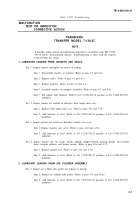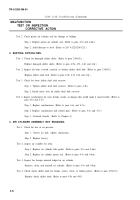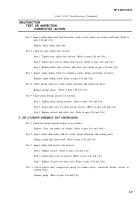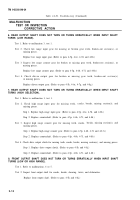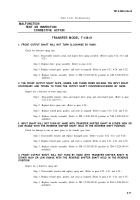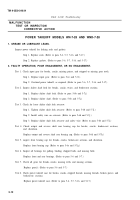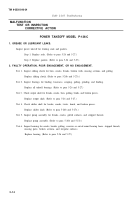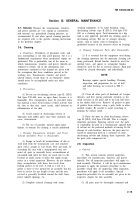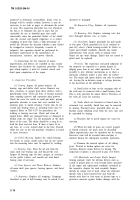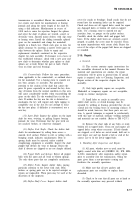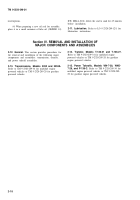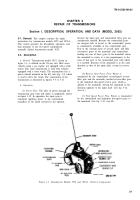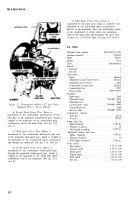TM-9-2520-246-34 - Page 34 of 153
TM 9-2520-246-34
transmission is assembled. Mount the mainshafts in
test centers and check for misalinement at bearing
journals and along the entire length of the shaft by
using a dial indicator. Misalinement in excess of
0.001 inch is cause for rejection. Inspect the splines
and reject the shaft if splines are twisted, scored, or
obviously worn. Smooth minor defects with slip stone
or honing stone. Install the sliding internally splined
gears on the mainshaft and clamp the mainshaft
upright in a bench vise. Check each gear, in turn, for
spline clearance by inserting a narrow feeler gage on
edge between the splines. Refer to repair and
replacement standards contained in the respective
chapter for each assembly. If clearance is in excess of
this established tolerance, check with a new gear and
new shaft to determine whether gear splines or shaft
splines are at fault. Reject the part at fault. Check
wear on front and rear bearings.
(11) Countershafts.
Follow the same procedure,
when applicable to the countershaft, as outlined above
for the mainshaft. Use a honing stone to smooth out
any burs, gouges, or scratches. Pay particular
attention to the section of the shaft that carries the
press fit gears, especially in and around the key slots.
Any deviation from the normal condition in this area
will cause considerable trouble when reassembling the
gears on the shaft. Try the woodruff keys in the key
slots. If neither the key nor the slot is distorted or
misshapen, the key will require only light tapping to
completely seat in the slot. Do not attempt to force
the key into place; if difficulty is encountered, use a
new key.
(12) Input Shaft.
Inspect the splines on the input
shaft for wear, twisting, or galling. Inspect bearing
journals for wear. Determine that the gear teeth are
not cracked, broken, or otherwise damaged.
(13) Shifter Fork Shafts.
Check the shifter fork
shafts for misalinement by rolling them across a
smooth, level surface. Failure to roll, or rolling with a
bumping sound, indicates misalinement. Bent or
sprung shafts must be rejected, unless suitable
straightening equipment is available. Inspect the shaft
poppet ball detents for wear or damage. Reject the
shaft if detents are chipped or are not sharply defined.
(14) Poppet Balls and Springs.
Reject all poppet
balls with flat spots and all weak or broken springs.
Use only those parts that are completely satisfactory.
(15) Shifter Forks.
Inspect shifter forks, paying
particular attention to the lower fork ends. Bent,
broken, or sprung parts are to be rejected outright, as
repairs are impossible. Worn parts may be used at the
discretion of the inspector.
(16) Shifter Shaft Cover.
Inspect shifter shaft
cover for cracks or breakage. Small cracks that do not
extend into the mounting holes can be repaired.
Check and clean out all tapped holes; mark for repair
any damaged holes or broken off studs in tapped
holes. Use a honing stone to smooth out any
scratches, burs, or gouges on the gasket surface.
Carefully check the shifter shaft and poppet ball
bores. If the shifter shaft bores are seriously scored,
gouged, or galled, the cover must be rejected. Clean
up minor imperfections with crocus cloth. Reject the
cover if the edges of the poppet ball bores are chipped
or rounded.
2-10. Repair.
a. General.
(1) This section contains repair instructions for
the assemblies discussed in this manual. Because the
material and construction are similar, the repair
instructions will be given in general form. If special
repair is required, refer to Cleaning, Inspection, and
Repair section of the respective chapter for the
assembly.
(2) Only high quality repairs are acceptable.
Makeshift or temporary repairs are not acceptable,
except in extreme emergencies.
(3) Small holes or cracks in assembly cases,
shifter shaft covers, or clutch housings may be
repaired by welding or brazing, provided they do not
extend into the bearing bores or mounting surfaces. It
should be noted, however, that these parts are cast
iron. A special technique is required to satisfactorily
weld this type of material; ordinary welding methods
and materials are not suitable. (Refer to TM 9-237.)
(4) Remove the short ends of any bolts or studs
broken off in tapped holes. Clean out and inspect all
tapped holes; retap where necessary. If hole threads
are stripped, or if holes are out-of-round, drill out to
next larger size and tap. Install a bolt or stud of the
correct size to fit the newly tapped hole.
b. Handling After Inspection and Repair.
(1) All parts, whether new or used, must be
lightly coated with lube oil (OE/HDO 30), ICE, MIL-
L-2104, immediately after inspection and/or repair,
prior to assembly into the transmission. Oiling the
parts gives them a rust-preventive coating and
facilitates the assembly operations.
(2) Make sure that all new gaskets and
replacement parts are available to replace those
discarded.
(3) Check to be sure that all parts are at hand so
the assembly operations may proceed without
2-17
Back to Top

